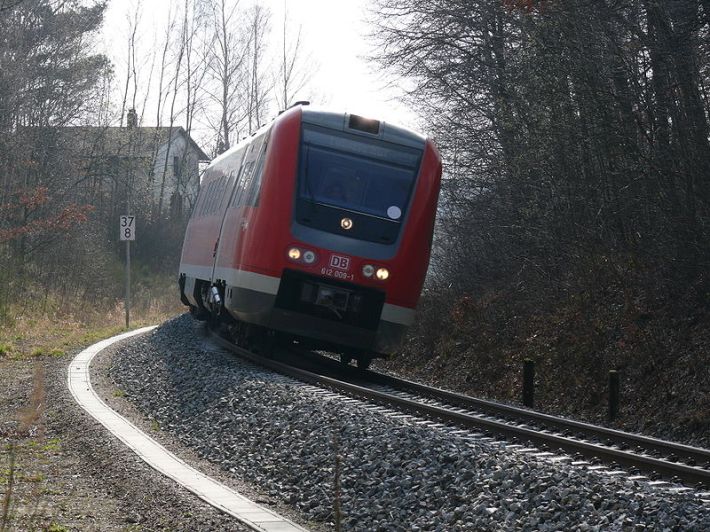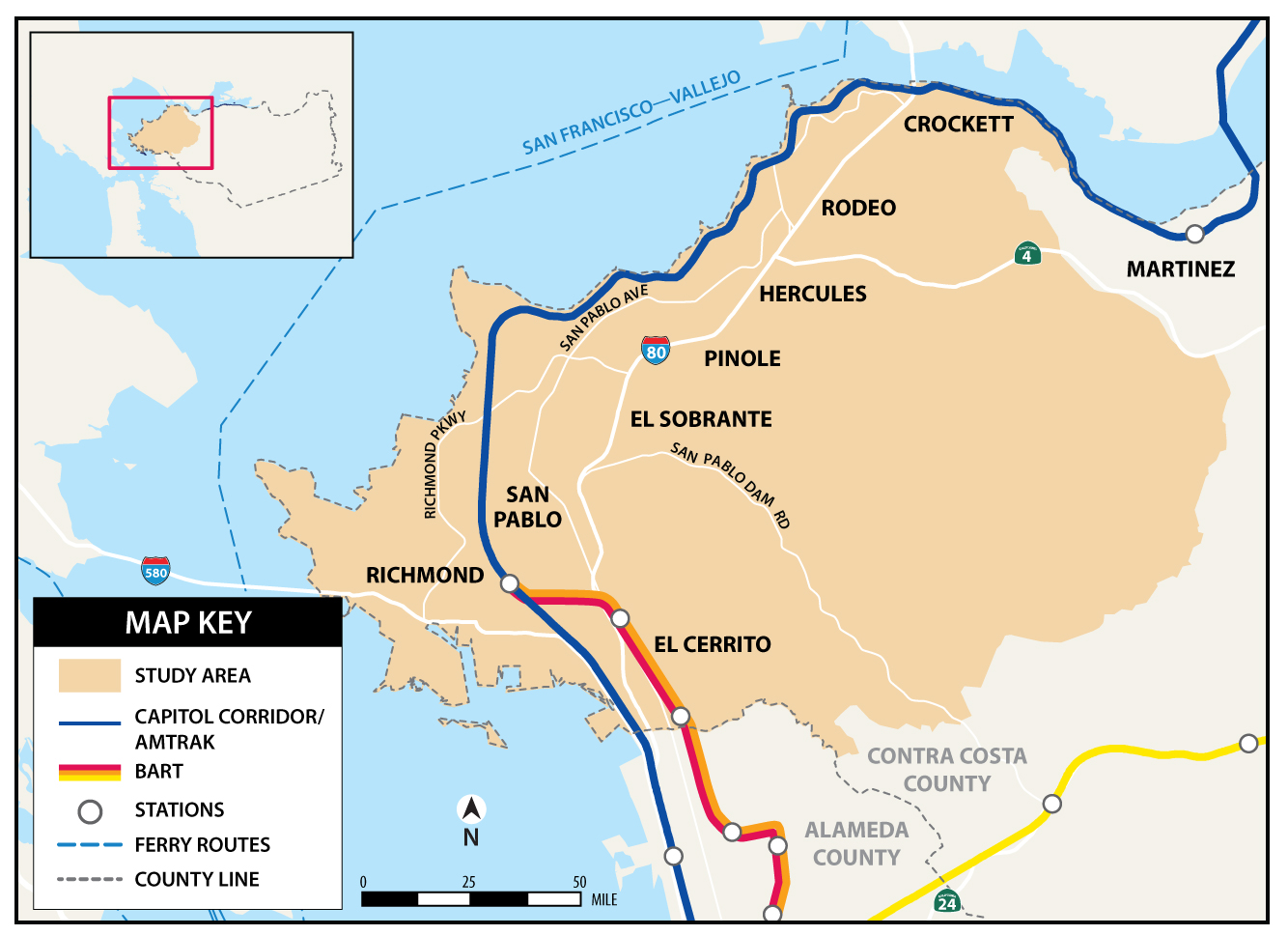The West Contra Costa Transportation Advisory Committee (WCCTAC), a body comprised of consultants and government officials, is finishing up presentations on its West County High-Capacity Transit Study.
From WCCTAC's web page:
The Study is focused on rapid and direct services that can attract new riders among the 250,000 residents of West County and can be a competitive alternative to driving. It will identify one or more projects to improve high-capacity transit in West County, expand alternatives to driving on congested streets and highways, and improve regional air quality and quality of life.
Interstate 80 is the most congested corridor in the Bay Area, and the Richmond BART line often reaches full capacity during commute hours. Expanded transit options and capacity would provide West County residents, including those located away from major corridors, with more convenient and comfortable access to employment centers in San Francisco, Oakland, Berkeley, and Emeryville, as well as the greater Bay Area job market.
The study looks at freeway-based express bus service, Bus rapid transit (BRT), Light rail transit, Commuter rail, a BART extension from Richmond, and ferry options, to provide a "planning and road map for West County jurisdictions to pursue funding for transit improvements."
The East Bay Times did this overview. And certainly, Streetsblog supports proposed bus improvements and additional ferry services, which can be implemented in the short term as rail options are explored. That said, Streetsblog has to bristle at the use of the term "high-speed bus." If an express bus qualifies as "high-speed," then the term is meaningless.
But what caught Streetsblog's attention was the quick dismissal of the idea of substantially using existing mainline rail assets. From page 43 of the study:
Technical Memorandum #8 examined two commuter rail alternatives, one involving additional passenger service on the Union Pacific (UP) line and the other involving the establishment of new passenger rail service on the Burlington Northern Santa Fe (BNSF) line. Both of these alternatives required substantial infrastructure investment to allow for additional capacity or the ability to accommodate passenger rail operations. They also required potentially complex negotiations with railroad owners.
When talking about such long-term planning and hundreds of millions to billions of dollars, it seems odd to toss out mainline/standard rail options so easily. For one, if "substantial infrastructure investment for additional capacity" is the problem, then how can a BART extension, nearly ten miles from Richmond to Pinole and Hercules, be on the table? Consider that the Warm Springs extension, which was half that length, cost $800 million. Caltrain electrification, for comparison, is slated to cost $1.5 billion, and involves replacing all rolling stock and upgrading signals and tracks--but that's for over 50 miles! Still expensive, but it shows how massive improvements can be made to an existing rail line for far less money than building a new one. Even adding additional tracks to the UP or BSNF is cheaper than building a whole new BART extension.
And, yes, "complex negotiations with railroad owners" is a problem, but how does that compare with NIMBY issues, tunnels and bridges, and the lawsuits that could complicate a BART extension?
John Nemeth, the executive director of the West Contra Costa Transportation Advisory Committee, which authored the study, said there were other issues. "In West County the UP and BNSF lines don’t run adjacent to large population centers and, except in Hercules, aren’t near where cities have Planned Development Areas," wrote Nemeth in an email to Streetsblog. "In the case of the BNSF, the nearby roads and surrounding property don’t lend themselves to serving as stations. For a BART extension, we developed an alignment that serves population centers and key destinations."
And, that said, they're not dismissing the existing Capitol Corridor service. The study suggests adding a station at Hercules, for example. It also examines the possibility of a "fare subsidy" to get Amtrak Capitol Corridor fares more in line with BART and other services. Streetsblog certainly supports this and hopes they will also integrate the Clipper Card, so it can be used on Amtrak, at least between Martinez and San Jose.

Of course, if Amtrak is cheap, it's bound to get more crowded--pointing again at the need to invest in more capacity on the existing corridor. Dennis Lytton, a rail transportation expert and advocate based in Albany, CA, thought the study neglected "the breadth of rail alternatives...new innovative rail equipment, such as Diesel Multiple Units (DMUs) that can tilt and take curves around our hills faster, are proliferating. Such systems are being built in Sonoma and Marin Counties (SMART), by BART in Antioch (eBART), in North San Diego (Sprinter), and many other places," he wrote in an email to Streetsblog.

But Nemeth said there were also concerns about the UP alignment's susceptibility to sea level rise. And even if they increased capacity with faster equipment and extra tracks along the BNSF or the current, UP/Amtrak alignment, there are still constraints to deal with beyond West Contra Costa, such as the slow stretch of tracks that run down the street through Jack London. "To run high frequency train service would require grade separated crossings at least around Jack London Square and portions of Oakland. Expanding the UP corridor to add more rail capacity was viewed as important but generally beyond the ability of West Contra Costa County and more of a regional and state issue," wrote Nemeth. For more on these issues, check out the 2014 Capitol Corridor Vision Plan.
He also pointed out that the trains wouldn't fit in the existing BART-gauged Transbay tube. That said, since there's no more capacity on San Francisco-bound Richmond trains during rush hour, as per WCCTAC's own study, it's unclear why that matters in the long term.
Furthermore, as Streetsblog has previously reported, the consensus is that when a second Transbay tube is built, it should be designed for standard trains, not BART's unique gauge--at least not unless enough money can be found to build four tracks, two for BART, and two for standard rail. That means if West Contra Costa is looking at planning for the distant future, it's not clear that extending BART, with its irregular tracks, is the way to increase one-seat capacity to San Francisco.
These kinds of long-term considerations are why, as Lytton pointed out, Marin/Sonoma opted for standard-gauge trains and even BART itself opted for standard-gauge rail for its eBART, East Contra Costa extension. That's why West Contra Costa might want to think some more about how it can do substantial improvements to its existing, standard-gauge/mainline rail assets in the shorter term, in ways that will be useful for long-term connections to a future Transbay tube, high-speed rail and Caltrain.
"It should be understood that the recommendation by the WCCTAC Board to further evaluate the BART alternative with an extension from Richmond was only within the context of the High Capacity Transit Study. Whether that alternative will (or should) be pursued beyond the study is another matter," said Nemeth. "Any BART extension would be extremely complex."
True enough. A final proposal, meanwhile, should be ready next month.






